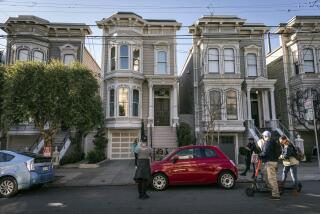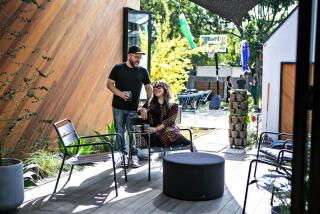HP Renovates Silicon Valley’s ‘Birthplace’
- Share via
While busy thinking about its future, Hewlett-Packard Co. also is quietly reclaiming its past.
The Palo Alto computer and printer maker -- which recently launched a high-profile corporate restructuring under a new chief executive -- is renovating the worn house and garage near Stanford University where the company was founded in 1939.
Now on the California historical registry, and officially designated as “The Birthplace of Silicon Valley” by the state, “It’s a humble, cottage-type home,” said Anna Mancini, HP’s archivist and historian.
There are no blueprints, but “we have recollections and anecdotes” to guide the work, she said. “There was a rose garden in back and a Murphy bed in the kitchen that you could pull down.” Workers are referring to a handful of old photographs for details about the porch and external trim, and what the inside was like.
William Hewlett and David Packard, electrical engineers who met at Stanford, rented the small two-story house on Addison Avenue in 1938 as they worked in the garage developing electronic instruments.
Packard and his wife, Lucile, lived on the ground floor while Hewlett occupied a shed out back. Together they paid $45 a month in rent to their landlady, who lived upstairs.
Now the company they created, with revenue of $80 billion last year, is nearing the end of an 18-month project to restore the house and garage, plank by warped plank.
The house was built in 1905 and the garage about 20 years later. The property had been a rental for years when HP purchased it -- for $1.7 million, according to the real estate website Domania.com -- in 2000. Renovators stripped the house and garage to their frames, shoring up foundations and strengthening beams with steel reinforcements to bring them up to earthquake codes. They replaced the roofs and plumbing.
Workers are doing their best to use original materials. Most of the original Douglas fir siding, for example, though warped and suffering from modest termite damage, could be repaired.
Among steps that had to be taken by HP -- a company whose motto is “Invent,” one that prides itself in leading the way into the future -- was reversing updates made to the house over the decades.
Walls had been put up when the second floor was subdivided into more apartments during World War II. Some were later removed, further changing the layout.
Workers expect to finish in October.
The original workplaces and tools of inventors and creators have a special place in human curiosity. Michelangelo’s house in Florence and Victor Hugo’s residence in Paris, for instance, are popular with tourists and historians.
Greenfield Village in Dearborn, Mich., has automotive entrepreneur Henry Ford’s boyhood home and the workshop where he invented the quadracycle, an early automobile.
“The reason we have such artifacts is to inspire people, to show that these people, while extraordinary in what they accomplished, had ordinary beginnings,” said Wendy Metros, a spokeswoman for The Henry Ford, an historic complex that includes Greenfield.
“When you think about what these people did in their time, when there was no Internet, the vision and fortitude they had are fascinating,” Metros said.
There are visitors from around the world. “I think it’s the most famous garage in the world,” Mancini said.
The draw is there for HP employees as well. An internal website tracking progress in the renovation gets 65,000 hits a month.
“It does represent the spirit of innovation,” Mancini said. “To them it’s inspiring for people to look at this garage and realize that a couple of people with some tools could start a company as large and successful as HP.”
For Hewlett-Packard, the spirit of the two founders still permeates the now-sprawling company, which has some 150,000 employees, years after Packard died in 1996 and Hewlett in 2001: Their original, linoleum-floored offices stand untouched, their doors standing open.
More to Read
Inside the business of entertainment
The Wide Shot brings you news, analysis and insights on everything from streaming wars to production — and what it all means for the future.
You may occasionally receive promotional content from the Los Angeles Times.










